Tilicho Lake Trek: Touch the Highest Lake on Earth
Introduction
The Tilicho Lake Trek is a breathtaking journey into the heart of the Annapurna region of Nepal, offering trekkers a chance to witness one of the world’s most stunning alpine lakes. At an astounding elevation of 4,919 meters (16,138 feet), Tilicho Lake is recognized as the highest lake of its size in the world. Surrounded by the majestic peaks of the Annapurna and Nilgiri ranges, this trek is perfect for adventure seekers and nature lovers looking to explore untouched Himalayan beauty.
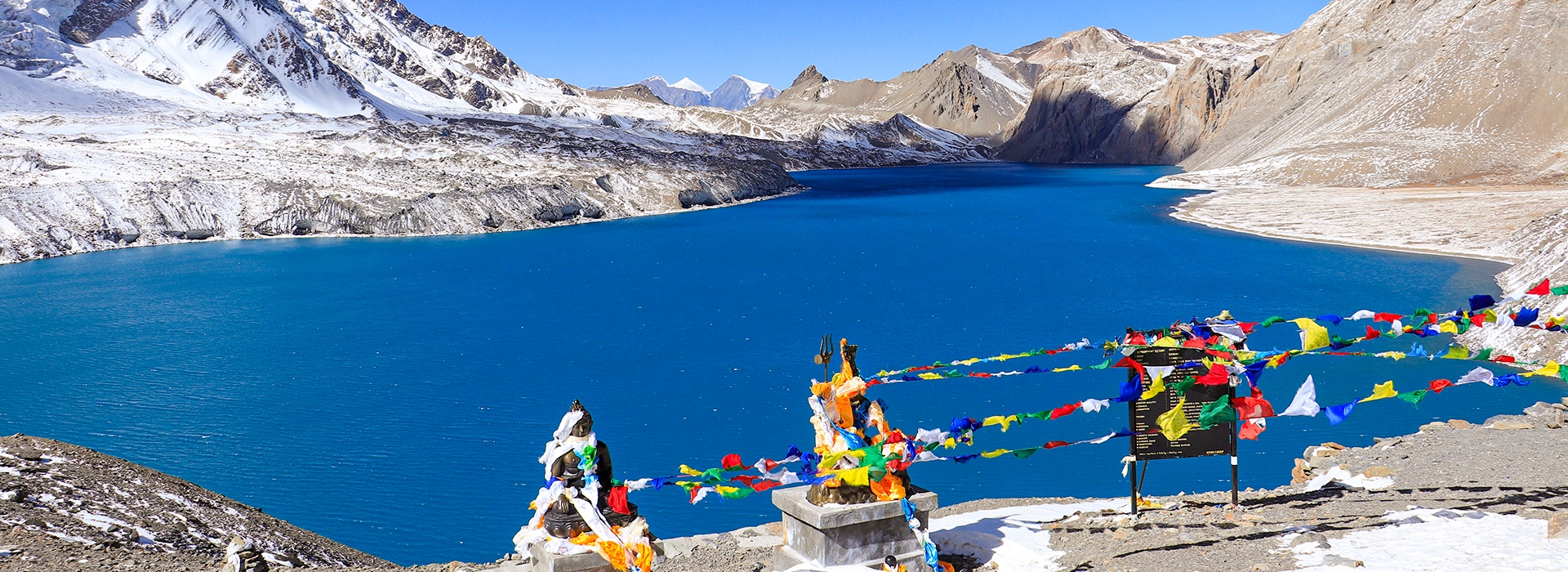
Source- Google
Why Choose the Tilicho Lake Trek?
1. World’s Highest Lake
It is situated at an altitude of 4,919 meters (16,138 feet), the highest in the entire world. It is created by the alpine glaciers surrounding Tilicho Peak’s meltwater. The scenery with the background of the beautifully turquoise-blue colored water of the lake against snow-white peaks and worn-down cliffs is simply breathtaking. It is a physical and spiritual vacation area for some of the trekkers. It is paradise for trekkers, home for those seeking solitude, a wonder of nature, and one of the most challenging places on earth. Tilicho Lake is reached with determination. The trek increases altitude gradually as it passes through even drier ground and thinner air. The reward, however, is well worth it.
2. Diverse Landscapes of Tilicho Lake
One of the Tilicho Lake attractions is that the scenery never becomes monotonous. The ascent begins in lower Annapurna on turning and switchback tracks through green subtropical jungle rimmed by rice terraces and waterfalls cascading down mountain slopes. Climbers continue, and the terrain begins to change: fir and pine will eventually predominate before the landscape goes on to include bare hills and cliff faces. And again, yet further on, too, when trekking inflicts on a land of arctic type, the latter gains country changes a new, desecrated by snowfields, glacier-valleys and ridges of ice-wrime on ultimate advance to country of lakes. A variety of choices scarcely ever furnished by a single trek is supplied by diverse climatic zones, conditions, and territories.
Each of these environmental niches along the way is different, with its pros and cons. Such topographic change is not a skin-deep phenomenon but quantifiable in terms of degrees of temperature, elevation, leaf and canopy cover, and even village culture in between. From emerald green sloping hill sides lined with spring blooms of rhododendron to Tilicho’s high-altitude desolate, barren, extraterrestrial-looking valley scenery, there is no scenery on this trekking path. But scenery lovers will have the trail revealing a different landscape each day, with the trekkers experiencing a different environment each day of the trek, as it progresses.
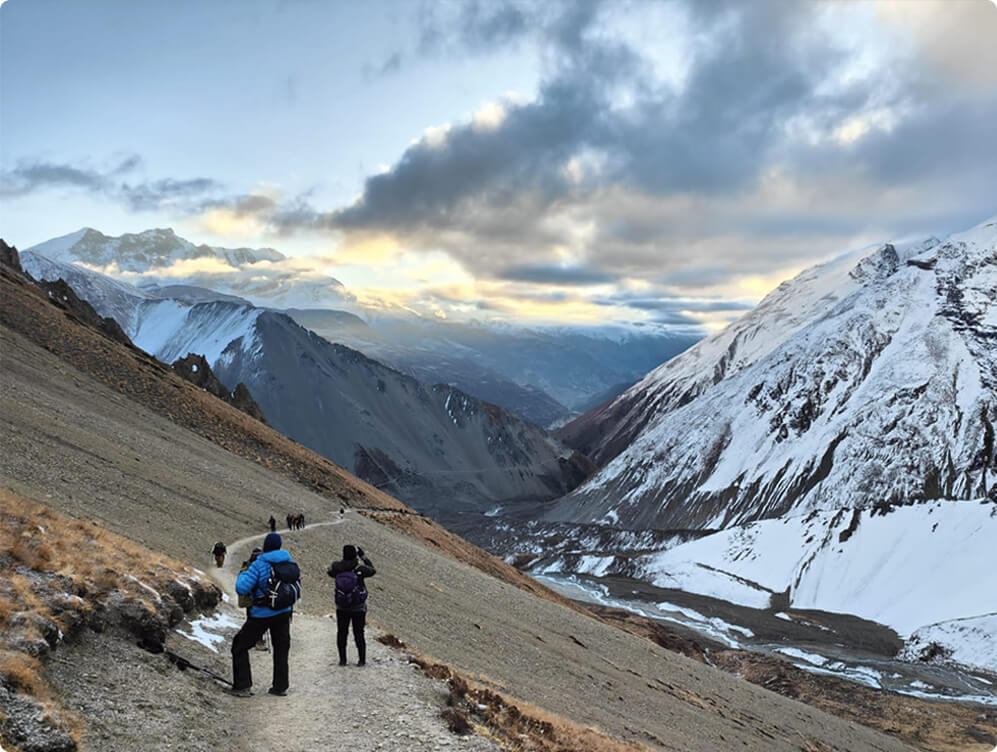
Source- Google
3. Cultural Immersion of Tilicho Lake
Scenery is only one of what makes up the Tilicho Lake Trek trekking destination trek through Manangi and Gurung, and Thakali culture village. Trekkers pass through Manangi and Gurung, and Thakali villages (all of Manang District), each with its own kind of tradition, language, clothing, and building style (and quite often some blend of these!). Though certainly off the tourist trail, they are said to be open and even to possess rich Buddhist and Hindu heritage. Prayer flags, spinning prayer wheels, ancient monasteries, and stone memorials are all part of a spiritual journey superimposed on the natural splendor of the trek.
The path near the teahouses permits people to observe daily Nepali activities. The meals are standard Nepali food, mainly dal bhat, as well as discussions with area residents cover farming, mountain living, or the old commercial road to Tibet. A cultural experience became a great memory from the trek for many people. The joining of deep cultural experiences and the thrill of height makes trekking hard for the body, plus difficult for the mind and emotions too.
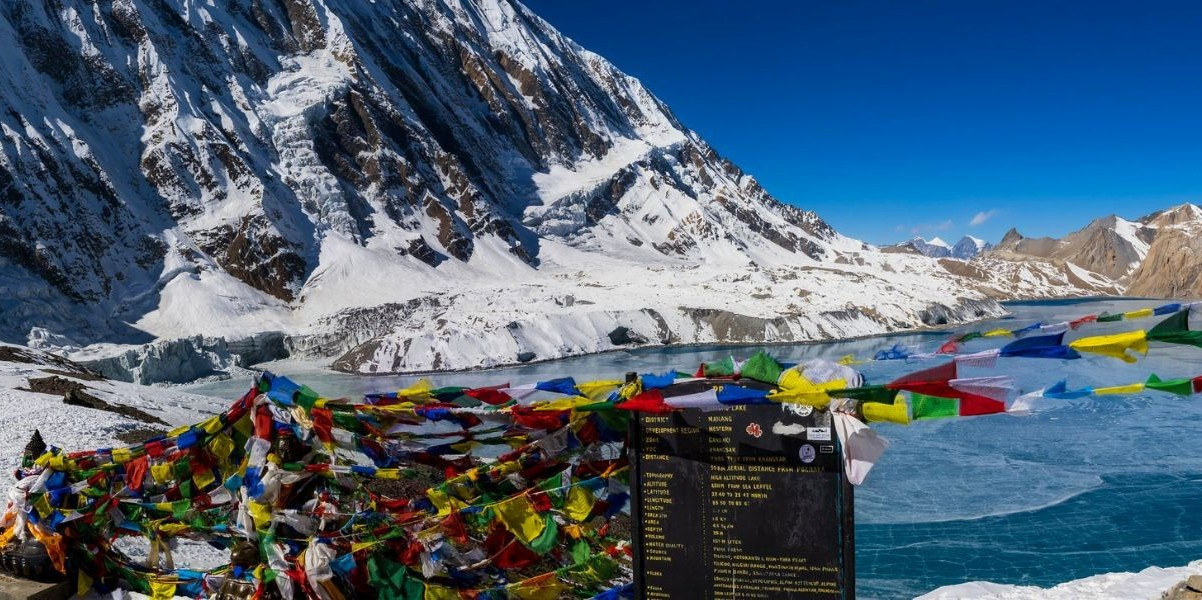
4. Wildlife and Biodiversity in Tilicho Lake
About the environment around Tilicho Lake, it looks tough, but it contains many living organisms. People trekking can view many kinds of plants and animals because they travel through different weather zones. Individuals trekking in low places are in an area having numerous birds, butterflies next to small mammals. When people trek higher, wildlife becomes harder to spot, but some common kinds, the Himalayan native, blue sheep, Himalayan tahr, in addition to marmots, can be found.
The region also gives benefits to birdwatchers. Himalayan monal, Nepal’s national bird, snow pigeons, as well as lammergeiers, fly above. The shifting areas for living hold different kinds of plants. Junipers, alpine shrubs next to medicinal herbs grow there. Conservation steps in the Annapurna Conservation Area help in the protection of this fragile environment. Because of this, it is a good path for those who love nature. For hikers, an understanding of an area that is sensitive to changes in nature and full of life makes the trip more meaningful. This joins travel with an understanding of the environment.
5. Unmatched Photography Opportunities in Tilicho Lake
The Tilicho Lake Trek is good for those who take pictures. It allows people to record both grand views and personal times related to culture. Each turn in the path presents something different. High mountains like Annapurna II, Tilicho Peak, in addition to Gangapurna, rise from the ground against bright skies. Large valleys come into view below hanging ice and old piles of dirt and rocks. The first parts of the day and the last parts of the day cover the mountains in bright light. This makes images that look too good to be true. The lake itself has a smooth surface, which shows snow-covered tops. It is one of the best places to take pictures in the mountains.
The trek has culture in the pictures. Prayer wheels turn in mountain winds, monks sing in monasteries, people pick crops along with yaks travel small paths. Each of these times tells a story. For those who look closely, the Tilicho Lake Trek has stories told through pictures. If you are a paid worker with a nice camera or someone who travels with a smartphone, the many subjects cause your camera to stay in your hand. The subjects include mountains, animals, people, as well as light. The journey can be seen as much as felt.
Trek Itinerary of Tilicho Lake
The journey usually requires 12 to 18 days. It starts at Besisahar. It goes up through diverse weather patterns toward Manang, then it shifts toward Tilicho Base Camp and the lake. Travelers can go back on the same path. They can proceed over the Mesokanto La Pass, at 5,099m, to get to Jomsom. The difficulty of the trek is between medium and hard. Correct adjustment to the altitude at Manang is important. March to May and September to November are the superior times for the trek. The weather is consistent, also the sky is clear.
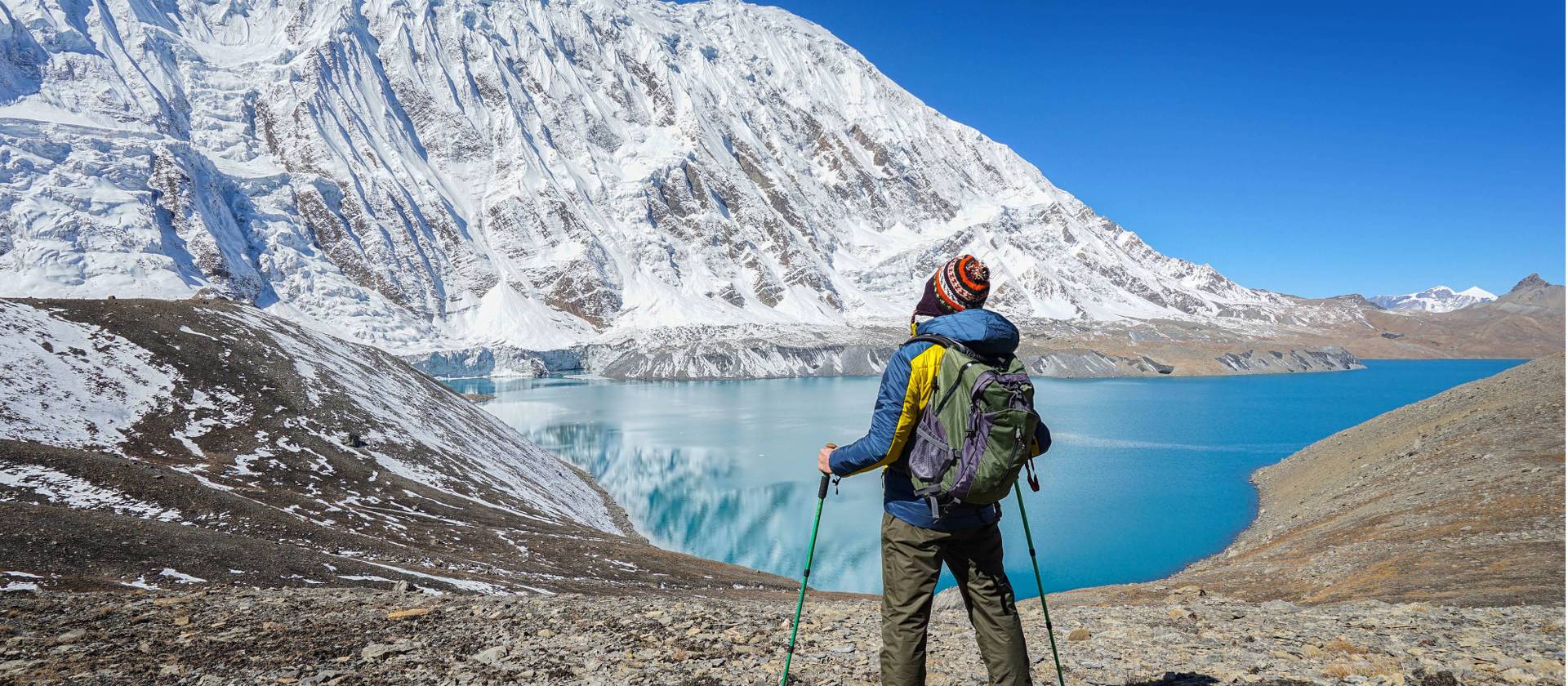
Detailed Itinerary Overview
Day 1: Drive from Kathmandu to Besisahar (760m)
The Annapurna region begins at Besisahar. The drive from Kathmandu to Besisahar starts the trek. The trip needs 6 to 8 hours, as traffic and road conditions influence the length. Hills with steps, rivers as well and country towns appear.
Day 2: Drive to Chame (2,670m) or trek via Jagat and Dharapani
A number of travelers take a jeep to Chame from Besisahar. Others start the trek at Jagat and Dharapani. The route goes past thick woods, water coming off cliffs next to little places to live. This part shows gorges that make a big impression besides the Marsyangdi River. The river is followed for days.
Day 3: Trek from Chame to Pisang (3,200m)
The path goes onward through thick forests that are pine forests. It goes beside dramatic walls of stone cliffs. Pisang comes after crossing a hanging bridge. Pisang is a town. The dry mountainous ground starts there.
Day 4: Trek from Pisang to Manang (3,540m)
Today, we have an option between the low and high road. The high road is more difficult but has incredible scenery of the Annapurna range and takes us through the lovely village of Ghyaru. Manang village is big with shops, bakeries, internet, and many teahouses.
Day 5: Acclimatization Day in Manang
It is an acclimatization day at high altitude. Trekkers typically take side trips to Gangapurna Lake, Ice Lake (Kicho Tal), or to the nearby monastery. Manang can also be utilized as a resupply point before proceeding to the less-traveled Tilicho trek.
Day 6: Trek from Manang to Shree Kharka (4,050m)
The trail then diverges from the Annapurna Circuit and heads for Tilicho Lake. The landscape continues to become more barren and dramatic as it moves further from the treeline. There is then the peaceful place of Shree Kharka with some teahouses and stunning mountain vistas.
Day 7: Trek to Tilicho Base Camp (4,150m)
The trail section is also equated with having steep pathways and slide regions, hence it’s best to hike carefully. The track gets more rugged and uneven, and the isolation of the trail is experienced as one gets to the base camp in the valley of the boulders.
Day 8: Visit Tilicho Lake (4,919m) and return to Base Camp or Shree Kharka
Set out early today as it is normally clear in the morning. The steep ascent leads to the stunning Tilicho Lake, with turquoise water lying quietly at the base of the mountain giants. Look about and take photos before descending to Tilicho Base Camp or higher still to Shree Kharka for overnight camping.
Day 9–10: Return to Manang or Cross Mesokanto La Pass (Optional Advanced Route)
More experienced and well-prepared trekkers can press on through the further, more strenuous, and occasionally snowed-in Mesokanto La Pass. This takes you to Jomsom, where you can either fly back to Pokhara. Alternatively, return to Manang and rejoin the classic Annapurna Circuit for a more manageable descent.
Day 11–14: Trek to Jomsom or exit via other lower routes
If coming back from Manang, trekkers may proceed to Yak Kharka and Thorong La Pass. Alternatively, they can descend to Chame and Besisahar, before heading back to Pokhara. In case those are taking the Mesokanto La route, they will stop in Khangsar or Yak Kharka for the night to arrive at Jomsom, a windy town with air connections to Pokhara.
Tilicho Lake Trek Difficulty and Preparation
The trek is rated moderate to difficult mostly because of altitude and terrain. Acclimatizing to the altitude is critical to avoid altitude sickness. Trekking experience is an advantage, but not necessary. A good level of fitness, mental preparation, and gear are necessary.
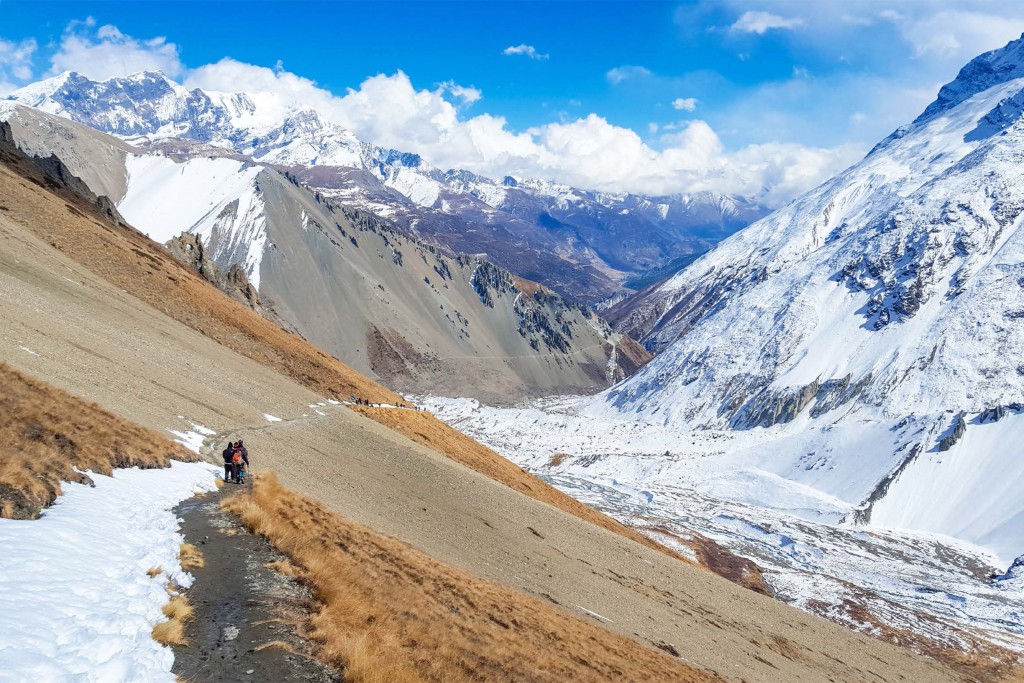
Preparation Suggestions:
- Train with cardio and strength equipment exercise for 1-2 months ahead of time.
- Bring an altitude illness medication, like Diamox.
- Dress in layers to allow for temperature changes.
- Hire a licensed guide or porter for navigation and support.
Permits and Regulations
Trekkers must get:
- Annapurna Conservation Area Permit (ACAP)
- TIMS Card (Trekkers’ Information Management System)
These can be obtained through registered trekking agencies or Nepal Tourism Board offices located in either Kathmandu or Pokhara.
Accommodation in Tilich Lake
1. Teahouses and Lodges
Accommodation options on the Tilicho Lake Trek are primarily teahouses and small lodges. These are available at most larger stops and are more or less comfortable depending on the height and location. Lower altitude lodges will be well equipped, but higher ones are more basic and simpler.
2. Room Facilities
Rooms usually offer twin bed configurations, basic bedding, and shared or connected washrooms at lower altitudes. Accommodation in teahouses doesn’t have heating, and if you are trekking at the greater height, then you definitely should carry with you also a good sleeping bag. It’s basic but adequate just for sleeping after a full day’s hike.
3. Mountain Hospitality
It’s further notion that the teahouses are often operated by local families, which helps cultivate a warm, friendly environment. They also function as social centers where trekkers of various nationalities meet.
Food in Tilicho Lake
Traditional Nepali Meals
A classic dish is dal bhat, consisting of rice with lentil soup and vegetables which trekkers can expect. It is a balanced diet; it provides energy and usually comes in the way of plates and dishes with bottomless pits which is made for the perfect lunch fuel of tough trekking days.
Variety of Options in Tilich Lake
In other foods, have noodles & soup, momo (dumplings), fried rice, pancake, and Tibetan bread in menus. Eggs are one step up, and in slightly more advanced villages you can get pasta, toast or even a hunk of basic pizza. There is more choice in the lower villages, but it declines as you go higher up.
Additional Amenities:
There should be boiled/filtered drinking water available but it is recommended to bring your own purification tablets or a filter bottle. Some teahouses (but mainly in lower elevations) have hot showers and phone charging available as well as a free Wi-Fi. Of course, as you keep climbing on top these amenities become limited so don’t forget to plan that ahead.
Timing Your Great Trek to Tilicho Lake
The best times to go:
Warm season (March – May): The rhododendrons and nice blue sky.
Autumn (September – November) has at least clear skies, good visibility of mountains, and cool, moderate temperatures.
Do not go during the monsoon season (June – August) because there will be landslides, slippery trails, and definitely a lot of trackable dirt, also desert. If you can avoid winter (December – March), unless you are an adept, truly experienced trekker.
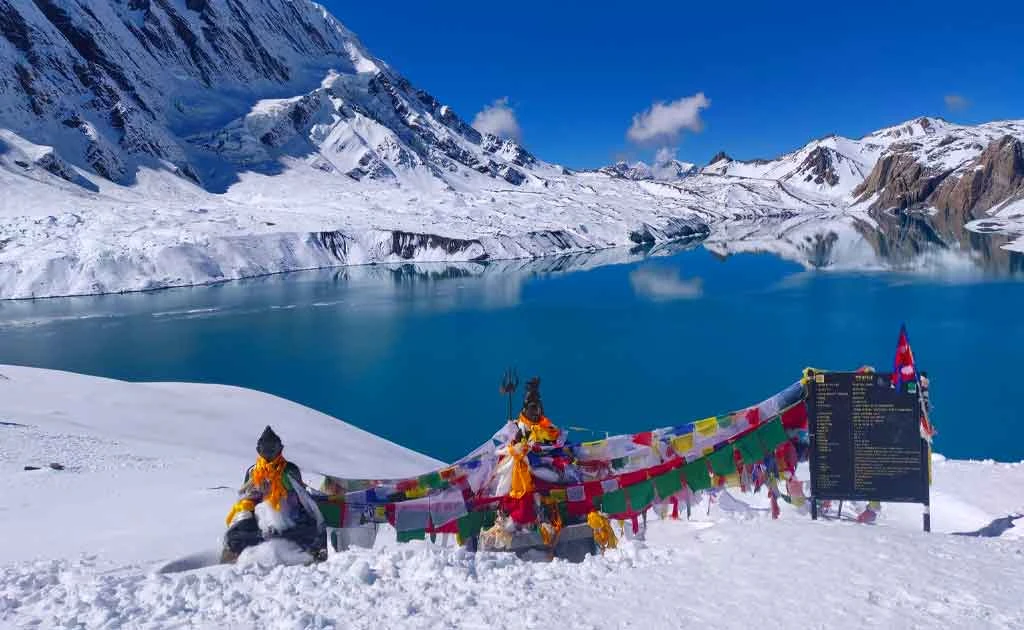
HERE ARE SOME GOOD SUSTAINABILITY TIPS FOR TREKKERS
- Bring your own bottles and avoid plastics or single-use plastics.
- Follow the local customary way, as you should use eco-friendly trekking agencies.
- I will pay for the tip if you pack out only dry “natural” trash.
Conclusion
The Tilicho Lake Trek it is not only a high-altitude trek, it is a caress on the soul of Himalaya. With every single step you take there is magic – from the tiny villages, snowy paths and their green lake waters. Don’t start being a seasoned hiker or a wishful lover of them, it is most definitely guaranteed to be an adventure of a lifetime.
READY TO TOUCH THE HIGHEST LAKE IN THE WORLD – Tilicho Lake! Contact us today at Happy Mountain Nepal, on Facebook, Instagram, or TikTok
